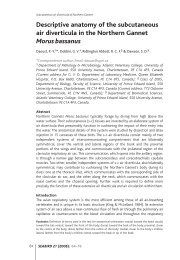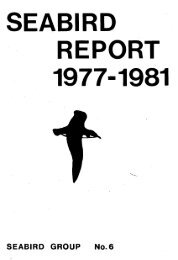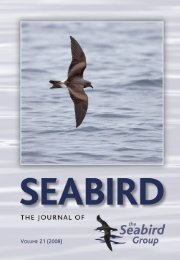You also want an ePaper? Increase the reach of your titles
YUMPU automatically turns print PDFs into web optimized ePapers that Google loves.
162 B. CADIOU Atlantic <strong>Seabird</strong>s 3(4)<br />
difficult to generalise (Beaugrand et al. 2000). Indeed, annual changes in the<br />
abundance of plankton in the English Channel during 1979-1995 were<br />
correlated with the NAO index but variation in plankton abundance in the Celtic<br />
Sea and in the Bay of Biscay were not (Beaugrand et al. 2000). <strong>No</strong> published<br />
oceanographic data for Celtic Sea appear to exist for 1996-1999, and data on<br />
diet collected on Banneg Island from regurgitates of adults or chicks are not<br />
adequate to identify any change (J. d’Elbée comm. pers.).<br />
Two questions remain; first, is the variability in laying period of<br />
European Storm-petrels a regular or occasional event and, secondly, whether it<br />
is a recent trend with a possible link to climate change. Only long-term studies<br />
on the laying phenology at different colonies, coupled with analyses of<br />
oceanographic and climatic data, will improve our knowledge. In this context,<br />
the European Storm-petrel might act as a potential indicator of changes in the<br />
marine environment.<br />
ACKNOWLEDGEMENTS<br />
Most of this work was carried out on the Iroise National Nature Reserve (Molène archipelago), land<br />
property of the ‘Conseil Général’ of Finistère, with funding from the ‘Conseil Régional’ of Brittany<br />
through a ‘Contrat Nature’ on seabirds in Brittany. I am very grateful to Jean-Yves Le Gall and<br />
David Bourles, wardens of the Reserve, and to all the volunteers involved in field work. Many<br />
thanks also to Kate Thompson for helpful comments on an earlier draft of the paper, to <strong>No</strong>rman<br />
Ratcliffe, an anonymous referee, Peter Becker and Jim Reid for improvement of the manuscript, and<br />
to Maïwenn Magnier for revision of the English version.<br />
BROEDBIOLOGIE VAN STORMVOGELTJES HYDROBATES PELAGICUS<br />
IN BRETAGNE, FRANKRIJK<br />
De afgelopen jaren (1996-1999), zijn gegevens verzameld over de broedbiologie van Stormvogeltjes<br />
Hydrobates pelagicus in kolonies langs de Bretonse kust in Frankrijk. De belangrijkste onderzochte<br />
aspecten waren legdatum, uitkomstsucces en uitvliegsucces. De gegevens werden verzameld door<br />
regelmatige controles van bezette holen en door het schatten van de kuikenleeftijd tegen de tijd dat<br />
de vogels geringd konden worden. De broedvogels keerden in maart of april op de nestplaatsen<br />
terug. De periode van ei-leg strekte zich uit van eind april tot begin augustus (!) en het tijdstip<br />
verschilde van jaar tot jaar sterk (mediaan half mei tot begin juli). Deze jaarlijkse verschillen<br />
werden vermoedelijk veroorzaakt door oceanografische fluctuaties en schommelingen in het<br />
voedselaanbod kort voor de eileg. Het hoeft geen betoog dat dermate grote verschillen in het tijdstip<br />
van leggen (en de daarmee samenhangende aanwezigheid van broedvogels op de kolonie)<br />
belangrijke implicaties had voor de onderzoekers. Gegegevens die gebaseerd worden op een enkel<br />
koloniebezoek moeten met grote terughoudendheid worden geïnterpreteerd, vooral wanneer alleen<br />
bandrecorders gebruikt worden om de populatie-omvang vast te stellen, omdat het percentage<br />
bezette nesten bij uitgestelde eileg buitengewoon laag kan zijn. Schattingen van het uitkomst- en<br />
uitvliegsucces bedroegen respectievelijk 65%-95% (over drie jaren) en 0.53 (één jaar). De eerste<br />
jongen vlogen half augustus uit, de laatste eind oktober of soms zelfs pas in november.








